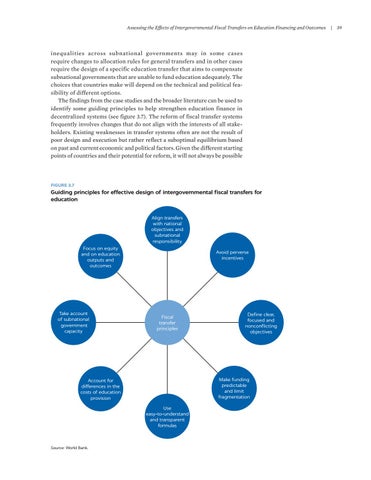Assessing the Effects of Intergovernmental Fiscal Transfers on Education Financing and Outcomes | 39
inequalities across subnational governments may in some cases require changes to allocation rules for general transfers and in other cases require the design of a specific education transfer that aims to compensate subnational governments that are unable to fund education adequately. The choices that countries make will depend on the technical and political feasibility of different options. The findings from the case studies and the broader literature can be used to identify some guiding principles to help strengthen education finance in decentralized systems (see figure 3.7). The reform of fiscal transfer systems frequently involves changes that do not align with the interests of all stakeholders. Existing weaknesses in transfer systems often are not the result of poor design and execution but rather reflect a suboptimal equilibrium based on past and current economic and political factors. Given the different starting points of countries and their potential for reform, it will not always be possible
FIGURE 3.7
Guiding principles for effective design of intergovernmental fiscal transfers for education Align transfers with national objectives and subnational responsibility Focus on equity and on education outputs and outcomes
Take account of subnational government capacity
Avoid perverse incentives
Fiscal transfer principles
Make funding predictable and limit fragmentation
Account for differences in the costs of education provision Use easy-to-understand and transparent formulas
Source: World Bank.
Define clear, focused and nonconflicting objectives






